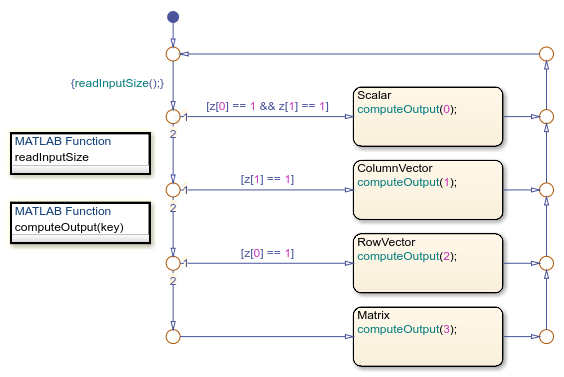디폴트 천이를 사용하여 초기 하위 상태 활동 지정하기
디폴트 천이는 두 개 이상의 인접한 배타적(OR) 상태 중에서 어느 상태로 진입할지 모호할 때 기본적으로 진입하도록 배타적(OR) 상태를 지정합니다. 디폴트 천이에는 대상이 있지만, 소스 객체가 없습니다. 예를 들어, 디폴트 천이는 이력 연결점 등 다른 정보가 없는 경우 시스템이 기본적으로 배타적(OR) 분해가 있는 상위 상태의 어느 하위 상태로 진입할지를 지정합니다. 디폴트 천이는 기본적으로 연결점으로 진입되어야 한다는 것도 지정할 수 있습니다.
디폴트 천이 그리기
도구 모음에서 디폴트 천이 버튼을 클릭하고 디폴트 천이의 대상으로 지정할 상태 또는 연결점 근처의 그리기 영역 내 위치를 클릭합니다. 마우스를 대상 객체로 끌어서 디폴트 천이를 연결합니다. 경우에 따라 디폴트 천이에 레이블을 지정하는 것이 유용할 수 있습니다.
일반적인 프로그래밍 실수 중 하나로 디폴트 천이가 없는 배타적(OR) 상태를 여러 개 만드는 것이 있습니다. 디폴트 천이가 없으면 어떤 상태가 기본적으로 활성화되는지에 대한 표시가 없습니다. 이 오류는 상태 불일치 옵션이 활성화된 모델을 시뮬레이션할 때 플래그가 지정됩니다.
디폴트 천이 레이블 지정하기
다른 천이와 마찬가지로 디폴트 천이에 레이블을 지정할 수 있습니다. 예를 들어, 발생한 이벤트에 따라 원하는 상태가 활성화되도록 지정할 수 있습니다. 천이의 대상에 따라 특정 작업이 수행되도록 할 수도 있습니다.
팁
디폴트 천이에 레이블을 지정할 때는 한 개 이상의 유효한 디폴트 천이가 있어야 합니다. 그렇지 않으면, 차트가 불일치 상태로 천이될 수 있습니다.
디폴트 천이 예제
다음 예제에서는 Stateflow® 차트에서 디폴트 천이를 사용하는 방법을 보여줍니다.
상태로의 디폴트 천이 예제
이 예제에서는 상태로의 디폴트 천이를 보여줍니다.

상태 PowerOff로의 디폴트 천이는 차트가 웨이크업 상태가 될 때 상태가 활성화되도록 합니다. 자세한 내용은 디폴트 천이를 사용하여 차트 실행 제어하기 항목을 참조하십시오.
연결점으로의 디폴트 천이 예제
이 예제에서는 연결점으로의 디폴트 천이를 보여줍니다.

연결점으로의 디폴트 천이는 차트에 진입할 때 그 대상이 각 천이 세그먼트의 조건에 따라 달라진다는 것을 정의합니다.
이 표기법의 의미 체계에 대한 내용은 연결점으로의 디폴트 천이 항목을 참조하십시오.
레이블이 있는 디폴트 천이 예제
이 예제에서는 레이블이 있는 디폴트 천이를 보여줍니다.

차트가 웨이크업 상태가 될 때 데이터 p와 v는 각각 10과 15로 초기화됩니다.
이 표기법의 의미 체계에 대한 자세한 내용은 레이블이 지정된 디폴트 천이 항목을 참조하십시오.